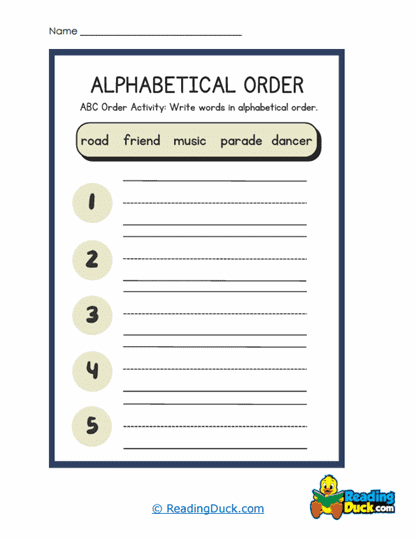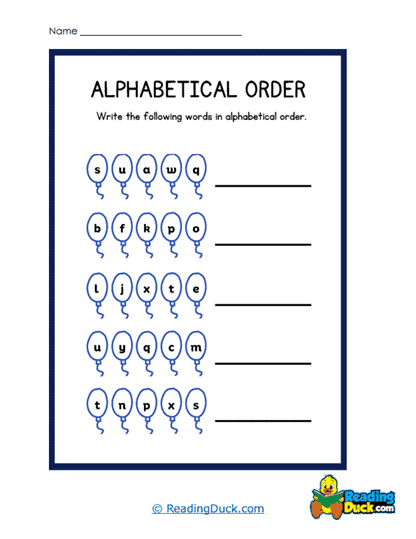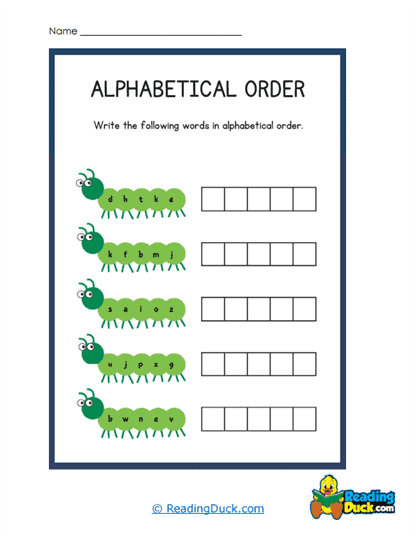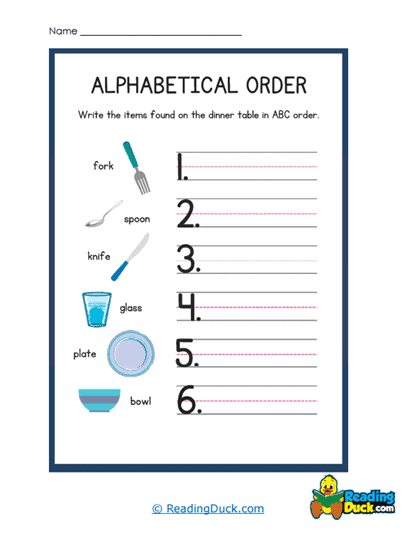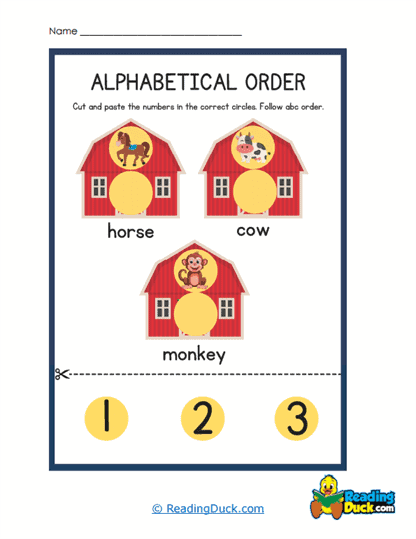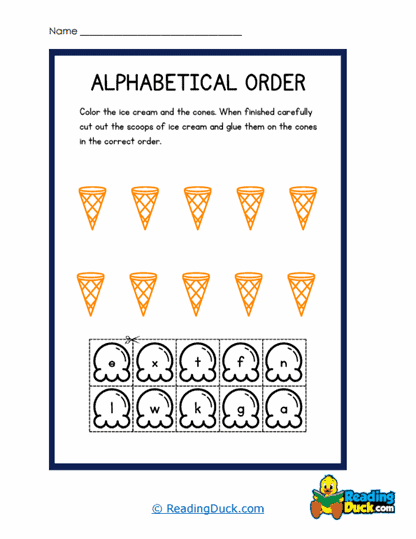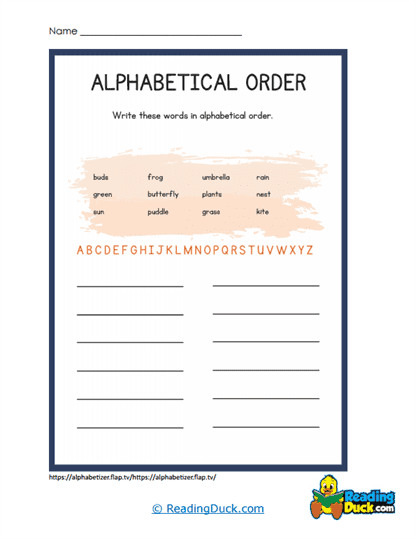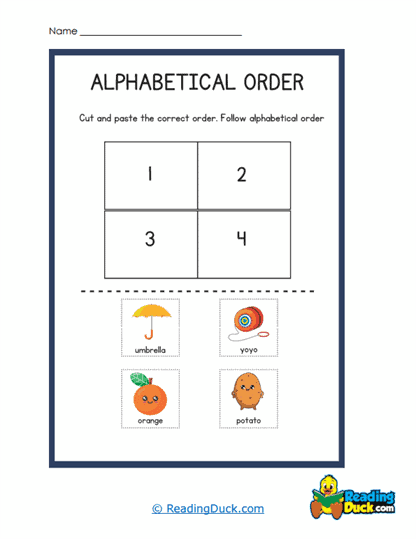Alphabetic Order Worksheets
About Our Alphabetic Order Worksheets
Our Alphabetic Order Worksheets are designed to engage young learners in mastering the concept of alphabetical order in a fun and interactive way. This collection includes various activities such as cut-and-paste exercises and writing tasks where students arrange letters or words in the correct sequence. Each worksheet is visually appealing to capture the attention of young students, ensuring that learning remains enjoyable. All worksheets are readily available in PDF format, making them easy to access, download, and print. An answer key is provided for each worksheet to support teachers and parents in guiding their students.
Understanding Alphabetic Order: The ABCs of Organization
The Importance of Alphabetic Order in Early Learning
Alphabetic order is one of the foundational concepts in early literacy development. It is not only a key skill for recognizing and organizing letters but also serves as a building block for more complex literacy tasks, such as dictionary use, spelling, and reading comprehension. Understanding alphabetic order helps young learners develop a sense of sequence and organization, which is essential in both academic and everyday contexts.
Here are some key aspects of teaching alphabetic order:
- Letter Recognition: Before children can master alphabetic order, they must first recognize and differentiate between letters. Alphabetic order activities reinforce this recognition by requiring students to identify and sequence letters.
- Sequential Thinking: Arranging letters in order fosters sequential thinking. Students learn to understand that each letter has a specific place in the alphabet, and this order is consistent and unchanging. This concept of sequence is fundamental to many other areas of learning.
- Organizational Skills: Learning alphabetic order also introduces students to basic organizational skills. By arranging letters or words in the correct sequence, students practice categorization and organization, which are essential skills for academic success.
- Preparation for Reading: Understanding the order of the alphabet is a precursor to reading. It helps students recognize that words are made up of letters arranged in a specific order, and this order affects meaning. This understanding is crucial for decoding words and developing reading fluency.
Engaging Young Learners in Alphabetic Order Activities
Teaching alphabetic order can be both fun and effective when approached with creativity and enthusiasm. Here’s how teachers can present this topic to students:
- Introduce the Alphabet: Begin by reviewing the alphabet, ensuring that students are familiar with all 26 letters. Use songs, visual aids, and interactive games to reinforce letter recognition.
- Explain the Concept of Order: Discuss the idea that letters have a specific order, much like numbers or steps in a process. Use examples that students can relate to, such as the sequence of their daily routine or the order of events in a story.
- Use Visual Aids: Display an alphabet chart in the classroom and refer to it frequently during activities. This visual reference helps students internalize the order of the letters.
- Interactive Practice: Engage students in hands-on activities where they can physically manipulate letters. This could include arranging letter cards, using magnetic letters on a board, or participating in group activities where they line up in alphabetical order.
- Connect to Real-World Skills: Explain how alphabetic order is used in real life, such as organizing names in a classroom, looking up words in a dictionary, or finding books in a library. This helps students understand the practical applications of what they are learning.
Creative Integration of Alphabetic Order Worksheets in the Curriculum
Incorporating Alphabetic Order in Classroom and Home Activities
Alphabetic Order Worksheets can be a versatile addition to any early literacy curriculum. Here are some creative ways to integrate these worksheets into your teaching:
- Morning Work: Use alphabetic order worksheets as a morning activity to warm up students’ brains and get them focused on learning.
- Literacy Centers: Include these worksheets in literacy centers where students can work independently or in small groups to practice alphabetic order.
- Alphabet Scavenger Hunt: Organize an alphabet scavenger hunt where students find objects that start with different letters and arrange them in alphabetical order. This can be a fun way to reinforce the concept of sequencing.
- Cut-and-Paste Projects: Use the cut-and-paste activities to create interactive learning experiences. For example, students can cut out letters and paste them in the correct order on a larger piece of paper, creating an alphabet mural.
- Story Sequencing: After reading a story, have students put the names of characters or key events in alphabetical order. This reinforces both comprehension and the concept of order.
- Alphabetical Classroom Jobs: Assign classroom jobs in alphabetical order based on students’ names. This not only teaches the concept but also gives students a sense of responsibility.
- Homework Assignments: Send worksheets home as a way for students to practice their skills with the help of their parents. This also helps parents understand what their child is learning in school.
- Interactive Whiteboard Activities: If you have access to technology, use interactive whiteboards to do alphabetic order exercises as a class. This can make learning more dynamic and engaging.
- Customized Alphabet Books: Have students create their own alphabet books, with each page dedicated to a letter and objects or names that start with that letter. Arrange the pages in alphabetical order to create a personalized learning tool.
Targeted Grade Levels
Alphabetic Order Worksheets are ideal for students in Pre-Kindergarten through First Grade. These grade levels are when students typically develop their understanding of the alphabet and begin to explore concepts of order and sequence. The worksheets can also be beneficial for older students in special education who may need additional support in mastering these foundational skills. Additionally, ESL (English as a Second Language) students at various ages can use these worksheets to build their English literacy skills, starting with the basics of alphabetic order.
The Impact of Alphabetic Order on Academic Development
Building Essential Skills Through Practice
Working with Alphabetic Order Worksheets provides students with more than just a basic understanding of the alphabet. These activities contribute to the development of several key academic and personal skills:
- Cognitive Development: Organizing letters in alphabetical order requires cognitive skills such as memory, attention, and logical thinking. These activities help strengthen students’ mental processes, making them better equipped to tackle more complex tasks.
- Problem-Solving Skills: Determining the correct order of letters or words involves problem-solving. Students must think critically about the sequence and use reasoning to make decisions.
- Language and Literacy Skills: Alphabetic order is directly related to literacy. Understanding how letters are organized helps students with spelling, dictionary use, and reading comprehension. It also aids in the development of vocabulary as students explore different words associated with each letter.
- Attention to Detail: Sequencing letters or words correctly requires careful attention to detail. This skill is important not only in literacy but in all areas of learning where precision is key.
- Independence and Confidence: As students practice and improve their alphabetic order skills, they gain confidence in their abilities. This confidence encourages independence in other academic tasks, as students feel more capable of handling challenges on their own.
Conclusion: The Role of Alphabetic Order in Early Literacy
Alphabetic Order Worksheets are a vital component of early literacy education. They provide young learners with the tools they need to understand and organize letters, which is a crucial step towards reading and writing proficiency. By integrating these worksheets into your curriculum, you offer students the opportunity to develop essential skills that will serve them throughout their academic journey and beyond. Whether used in the classroom or at home, these worksheets are a valuable resource for fostering a love of learning and building a strong foundation in literacy.
